There’s something almost ceremonial about making a creamy truffle mushroom soup. The moment the mushrooms hit the heat and release that rich, earthy aroma—you just know you’re about to create something special. For those of us who’ve spent time in the woods foraging or in markets sniffing out the freshest fungi, this soup feels like the pinnacle of what mushrooms can become in a dish.
There’s a reason high-end restaurants feature truffle mushroom soup on their winter menus: it’s luxurious but honest. Rustic but refined.
And here’s the part I care about as a mushroom enthusiast—it doesn’t have to be exclusive. With a few smart choices, anyone can bring this dish into their kitchen and make it shine.
Ingredients That Make This Soup Legendary
This soup lives or dies by its ingredients. You can’t cut corners here and expect elegance on the plate. Every element in this soup plays a role, like a symphony where one flat note ruins the harmony.
If mushrooms are the body, truffles are the soul. I’ve used both black and white truffles in this recipe at different times, and each tells a different story. Black truffles (Tuber melanosporum) bring a deep, musky, almost chocolatey aroma. They’re grounding. White truffles (Tuber magnatum), on the other hand, are piercingly aromatic—intensely garlicky and a bit sharp—more of a top note than a base.

I lean toward black truffle oil or preserved black truffles for everyday cooking—they’re more forgiving and easier to balance.
The trick is to use them at the end. Heat kills the nuance. Just a drizzle or a few shavings over the finished bowl brings everything to life.
Mushrooms For Layered Umami
This isn’t a place for button mushrooms to play solo. You need range.
Here’s what I use and why:
- Cremini: Meaty and reliable. The foundation.
- Shiitake: Woodsy, almost smoky. Adds depth.
- Porcini (dried, rehydrated): Rich, intensely savory. Think of them as natural MSG.
- Oyster mushrooms: Delicate and slightly sweet—great for texture.
Fat-Enriched Cream
Go full-fat or go home. Heavy cream binds the flavor and texture together, making the soup silky without muting the earthiness. You can swap in full-fat coconut cream for a dairy-free version, but it changes the tone—adds a hint of sweetness and a tropical note. It’s not worse, just different.
Stock As The Backbone
If you only remember one thing from this entire article, let it be this: mushroom stock is absolutely essential. While chicken or vegetable broth will technically work, they simply can’t match the depth of a proper mushroom stock.
I make mine by simmering mushroom stems, dried mushroom pieces, and vegetable scraps for about an hour. The resulting amber liquid concentrates all those wonderful fungal flavors and forms the backbone of your soup. Trust me, this step makes the difference between a good soup and an unforgettable one.
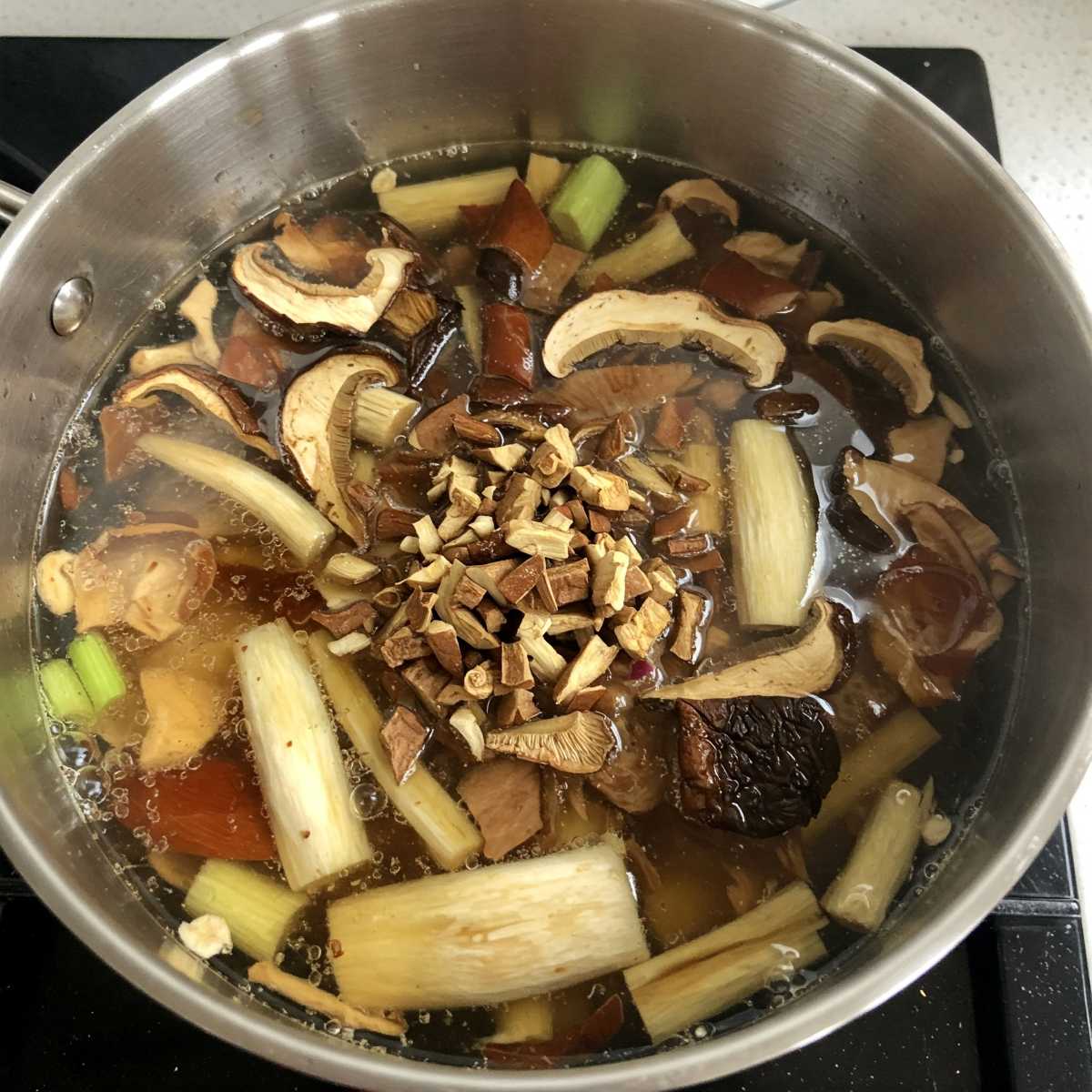
Sourcing Truffles Without Going Broke
Fresh truffles cost a small fortune. A single black truffle can easily run $50-100, while premium white Alba truffles can reach several hundred dollars per ounce. But don’t worry – you have options that won’t require a second mortgage.
Finding Actual Truffle Oil
Most truffle oils on the shelf don’t contain real truffles. They’re infused with synthetic flavorings—usually 2,4-dithiapentane.
I’ll be blunt: many of them taste like gasoline-drenched mushrooms. That’s why I’m picky. Look for oils made with actual truffle extract or ones labeled “aroma naturale di tartufo.” Price is usually the giveaway—if it’s cheap, it probably tastes cheap.
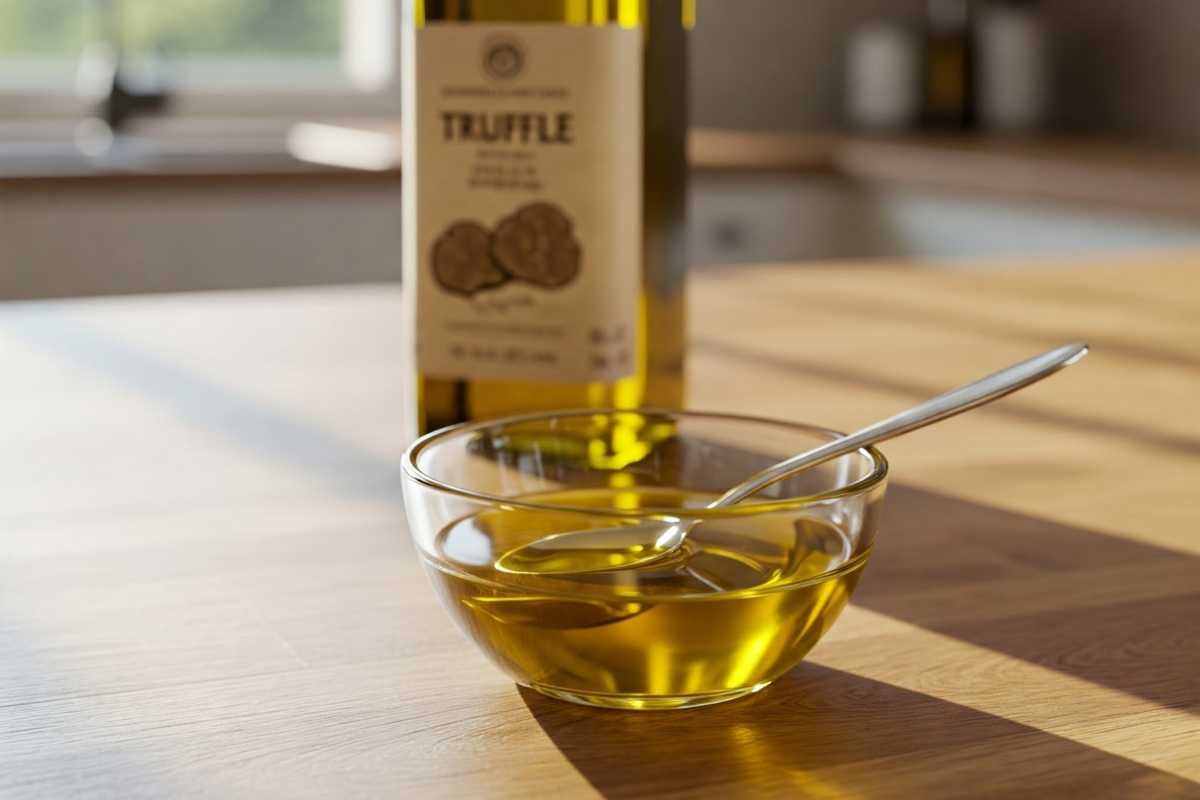
Use sparingly. A few drops are all you need. And never cook with it—truffle oil should go in after the soup is off the heat.
Preserved Truffles: A Practical Middle Ground
Jars of truffle slices in oil or truffle paste are my go-to for special dishes. They’re more stable and cost-effective than fresh, and the flavor—while subdued—is still real. Mix a teaspoon into the soup right at the end, and it’ll sing.
Fresh Truffles (Optional but Glorious)
If you happen to stumble across fresh truffles in a specialty store or are feeling indulgent, by all means—go for it. Store them in dry rice or wrapped in paper towels inside a sealed container. Shave over the finished dish. Don’t mix them in; let them do what they do best—hover aromatically over everything.
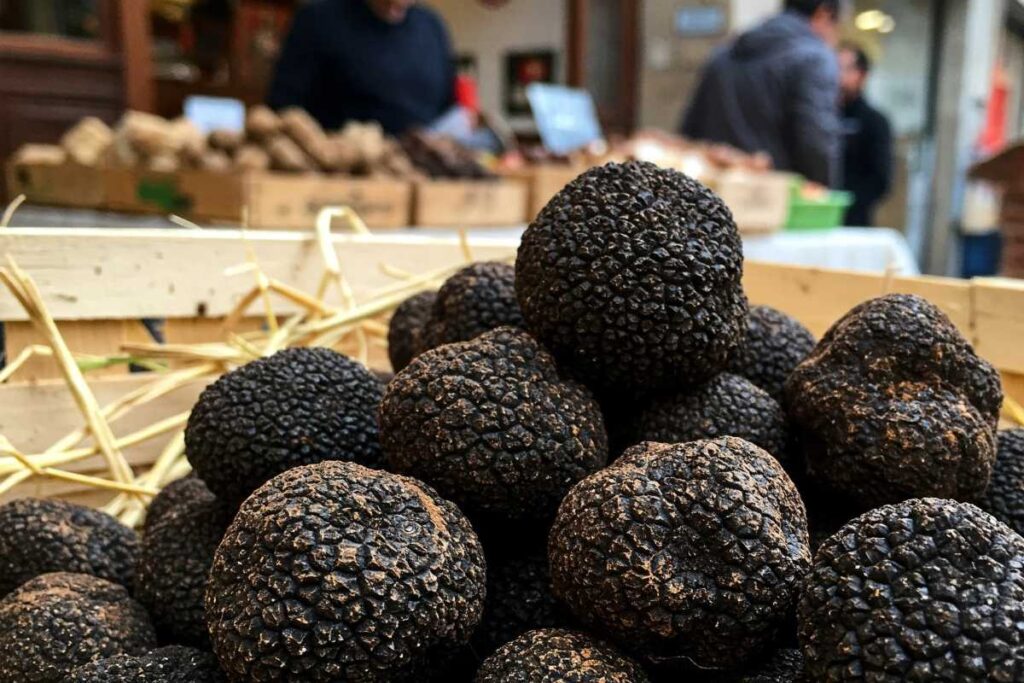
Where to Find Quality Truffle Products
- Online: Look for European brands (Italian and French origin usually means higher quality).
- Farmers’ markets: Some local truffle farms sell preserved products.
- Specialty grocers: High-end grocery chains or gourmet shops carry small-batch oils and pastes that beat the mass-market stuff.
And just to put it in context, according to a 2024 study in Sustainability, the global demand for truffles continues to grow—not just because of flavor, but due to their ecological and cultural value. So sourcing ethically and sustainably matters too.
The Secrets to a Silky, Complex, Flavor-Balanced Soup
If the ingredients are your tools, then technique is your craftsmanship. You can have the best mushrooms and truffles in the world, but if your process is rushed or careless, the soup won’t deliver.
Here’s how to do it right.
Saute Slow, Build Depth
Start with shallots and garlic, low and slow in butter and olive oil. This is your flavor base—don’t rush it. You want translucency, not color. Once your kitchen smells like the inside of a cozy woodland cabin, you’re on the right track.
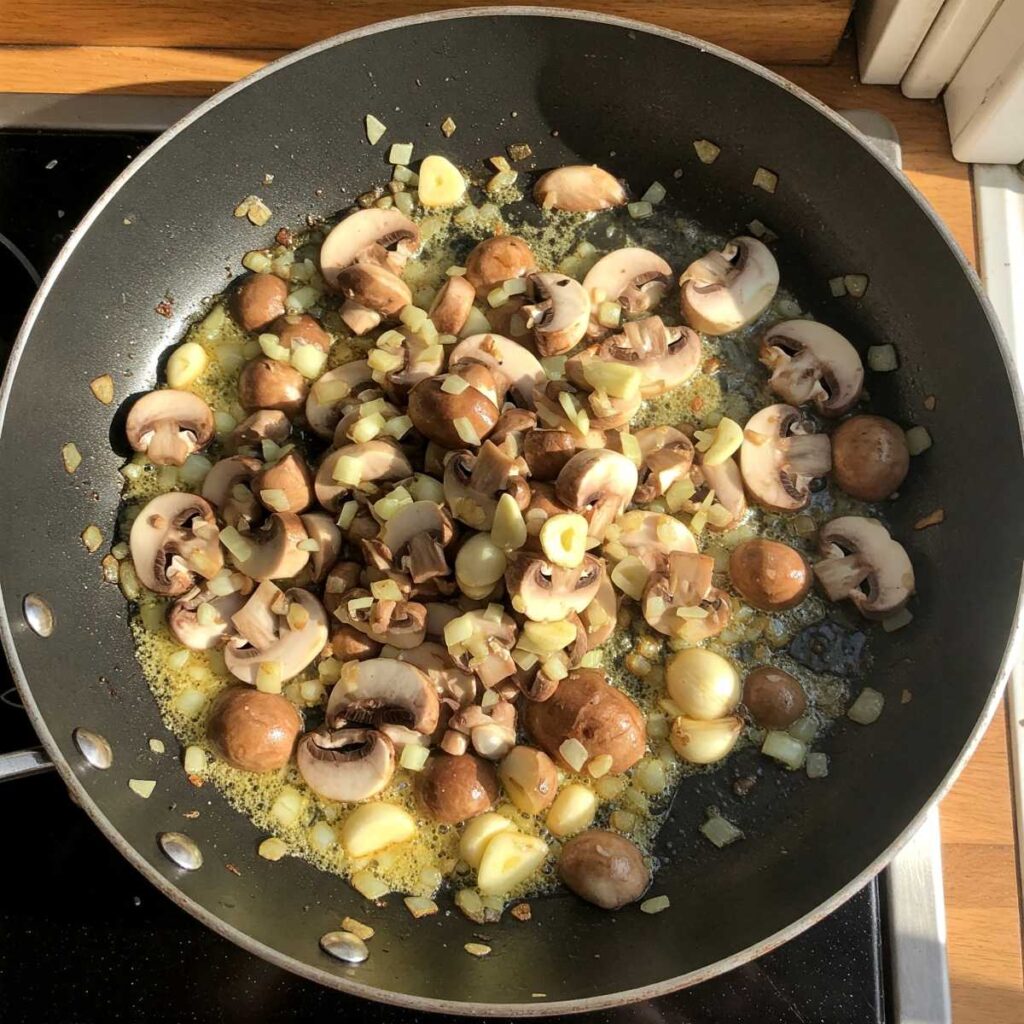
Add the mushrooms in batches, not all at once. Mushrooms release moisture—crowding the pan means they’ll steam instead of brown. Browning = flavor. Let them sit before stirring. Give them space to develop that golden edge.
Deglaze Thoughtfully
Once the mushrooms have released their water and started to caramelize, hit the pan with dry white wine or a splash of sherry. Scrape up every bit of fond (those browned bits on the bottom of the pot). That’s concentrated umami, and it needs to be in your soup.
Avoid sweet wines—they’ll throw the balance off. Dry, acidic wine cuts through the fat and lifts the flavor.
Stock Simmer, Not Boil
Once the wine reduces, add your mushroom stock. Let it simmer gently—this isn’t a hard boil situation. You’re coaxing, not forcing. Simmer for 15–20 minutes to let everything settle into one another. It’s not about cooking time—it’s about cohesion.
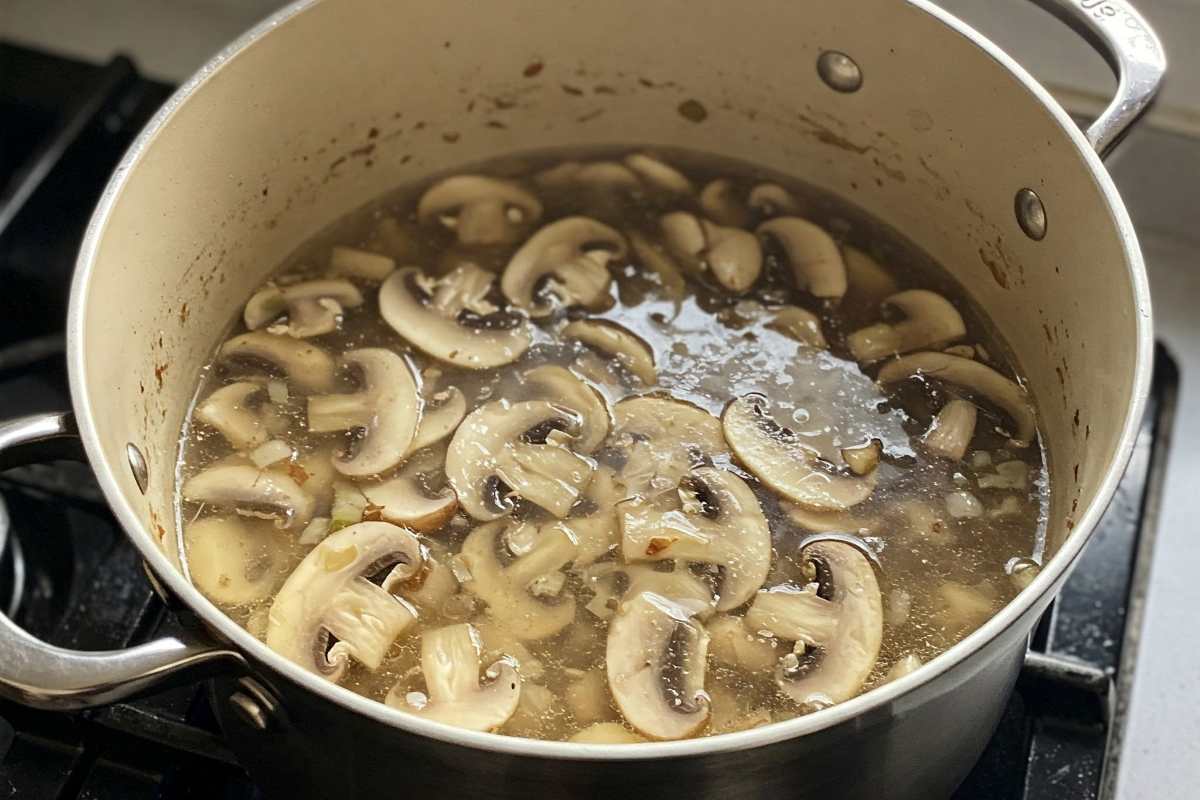
Blend for Texture (or Don’t)
This is personal. I like to blend about three-quarters of the soup and leave the rest chunky. You get that smooth, velvety base with bites of real mushroom. A full puree feels restaurant-fancy but can become monotonous in a home setting. Play with ratios until you find what fits.
Use an immersion blender for ease, but a high-powered blender will give a smoother result. Cool it slightly before blending to avoid a mushroom eruption all over your kitchen.
Add Cream and Truffle After
This part is sacred. Do not boil cream. Do not cook truffle oil. Stir in the cream after blending and warm it through gently. Then—off the heat—add your truffle oil or truffle paste. This preserves every aromatic molecule and keeps the soup tasting fresh, not flat.
Add salt and cracked black pepper last. Mushrooms concentrate flavor as they cook, and the stock might already be seasoned. Taste. Then season. Always.
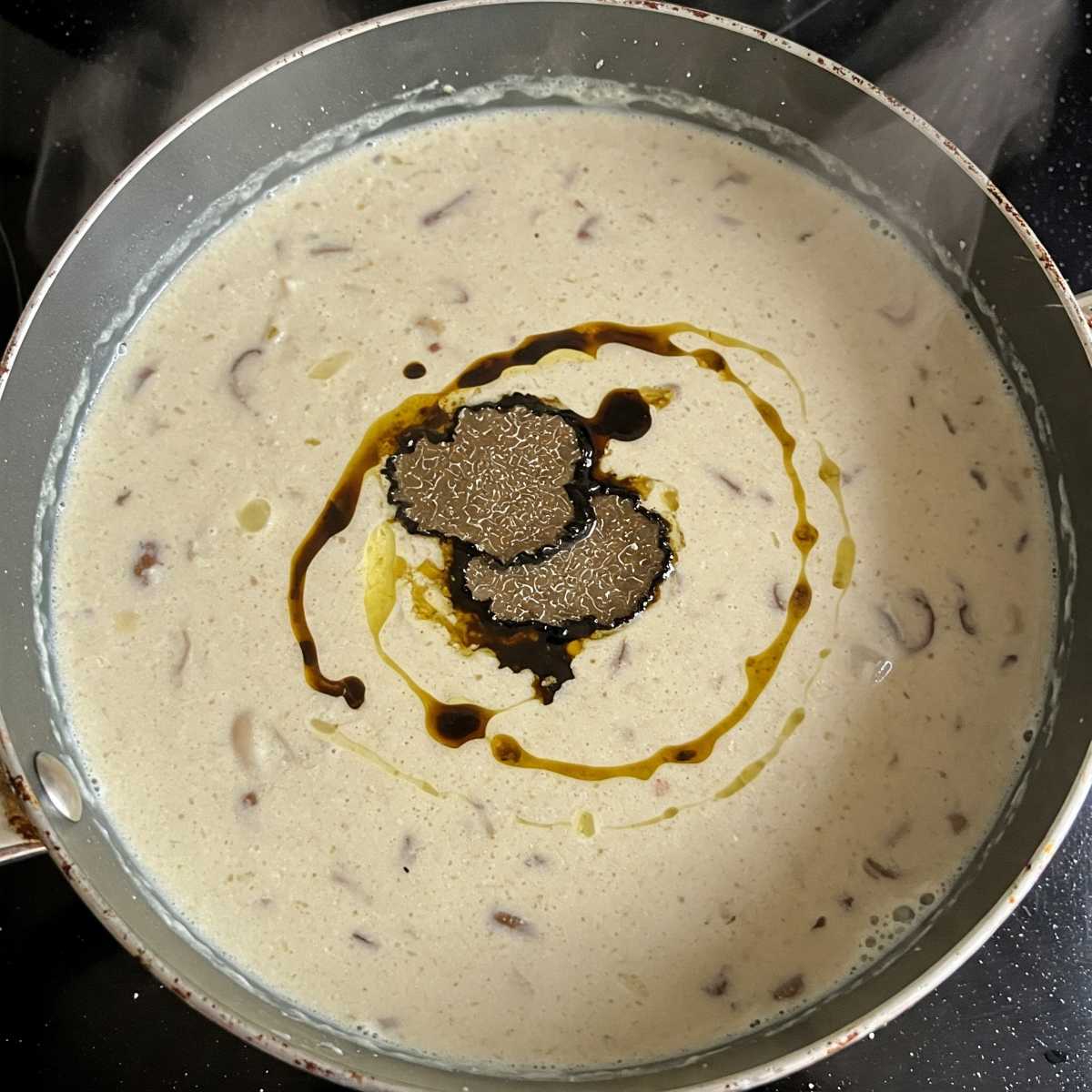
The Right Way To Serve And Pair
If you’re going to put this much care into a soup, don’t just plop it in a bowl and call it done. The way you serve this matters—it’s the moment you invite people into the experience you’ve created.
Garnish with Intention
A good garnish should do one of three things: add contrast, enhance aroma, or boost texture.
Here’s what I recommend:
- A swirl of chive oil or extra virgin olive oil for color and a fresh note.
- Crisped mushroom slices on top—pan-fried until golden and chewy.
- A few paper-thin shavings of truffle (if you’re using the real thing).
- Microgreens or fresh thyme leaves for brightness.
It should look like it smells amazing. People eat with their eyes first.
What to Serve Alongside
This soup is rich, so pair it with something crisp or rustic:
- Toasted sourdough: Simple, crusty, perfect for dragging through the bowl.
- Gruyere crostini: A small, thin slice of bread toasted or grilled and is topped with melted Gruyere cheese. Adds nuttiness and crunch.
- Mixed greens with lemon vinaigrette: Keeps the meal from feeling too heavy.
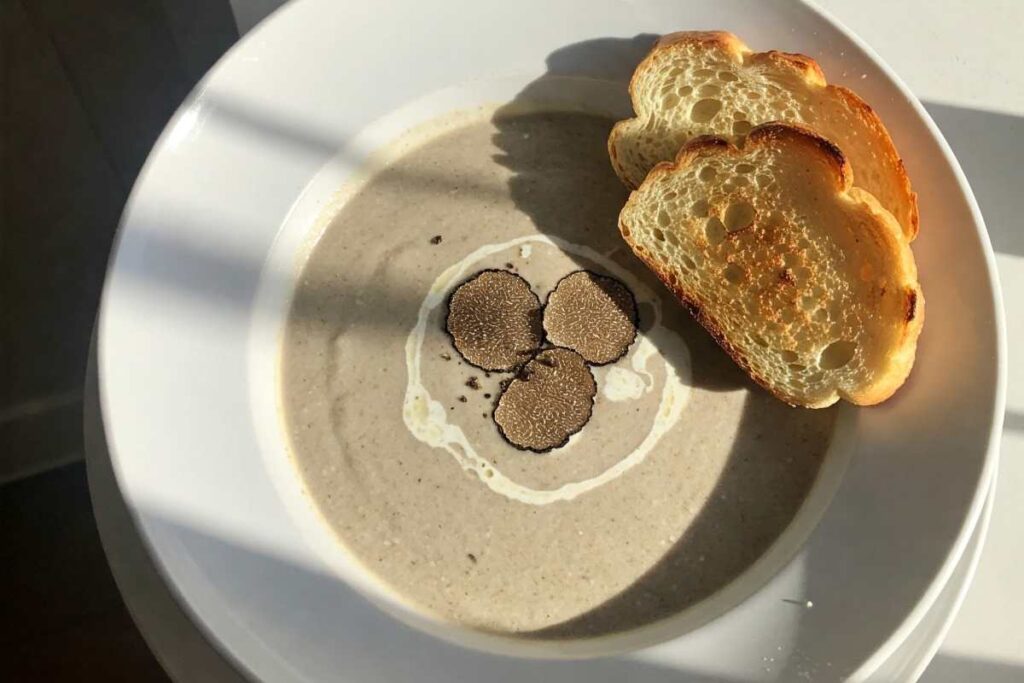
Wine Pairing
Go with a dry white like Chardonnay (unoaked) or Pinot Grigio if you’re keeping it light. But if you want something cozier, a light red like Pinot Noir complements the earthiness without overpowering it.
If you’re skipping wine, go for sparkling water with a squeeze of lemon—cleanses the palate between bites.
The truffle aroma fades fast, so eat it fresh when possible.
Final Thought
This soup teaches patience and attention in the kitchen. Unlike dishes where you can rush or substitute carelessly, here, every step matters.
When you nail it—when you take that first spoonful of perfectly balanced, velvety soup with the haunting aroma of truffle—you’re experiencing something that connects you to forests, seasons, and centuries of mushroom hunters before you.
Follow the given Recipe below. Make it once with care, and I promise you’ll never look at mushrooms quite the same way again.
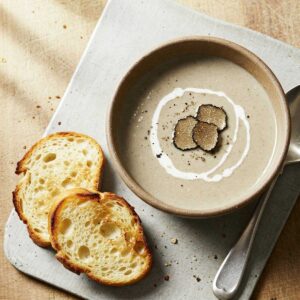
Creamy Truffle Mushroom Soup
Equipment
- Large saute pan
- Deep saucepan or stockpot
- Blender (immersion or countertop)
- Wooden spoon
- Cutting board + sharp knife
Ingredients
- 2 tbsp olive oil
- 1 tbsp unsalted butter
- 2 medium shallots finely chopped
- 3 garlic cloves minced
- 200 g /7 oz cremini mushrooms, sliced
- 100 g /3.5 oz shiitake mushrooms, stems removed, sliced
- 20 g 0.7 oz dried porcini mushrooms, rehydrated and chopped
- 100 g /3.5 oz oyster mushrooms, torn into strips
- 1/4 cup dry white wine Sauvignon Blanc or similar
- 4 cups mushroom or vegetable stock
- 3/4 cup heavy cream
- 1 tsp truffle paste or 1 tbsp high-quality truffle oil
- Salt to taste
- Cracked black pepper to taste
Instructions
Sauté the aromatics
- Heat olive oil and butter in a large saucepan over medium heat. Add shallots and garlic. Cook until softened and fragrant—about 5 minutes.
Cook the mushrooms
- Add mushrooms in batches to avoid overcrowding: start with cremini and shiitake, followed by porcini and oyster mushrooms. Sauté until golden brown and reduced in size. This should take about 10–12 minutes total.
Deglaze the pan
- Pour in the dry white wine. Stir well, scraping up any bits from the bottom. Let the wine reduce by about half, around 2–3 minutes.
Simmer with stock
- Add the mushroom or vegetable stock. Bring to a simmer, not a boil. Let everything meld together gently for 15–20 minutes.
Blend the soup
- Using an immersion blender, blend the soup until mostly smooth, leaving some texture. Alternatively, cool slightly and blend in batches in a countertop blender for a silkier finish.
Add cream and finish
- Return soup to low heat. Stir in the heavy cream and warm gently—do not let it boil. Remove from heat and stir in the truffle oil or paste.
Season and serve
- Add salt and cracked black pepper to taste. Ladle into bowls and garnish with crispy mushrooms, fresh thyme, chive oil, or truffle shavings if desired.
Notes
- For a dairy-free version, use full-fat coconut cream and replace butter with olive oil.
- If using dried porcini, rehydrate them in warm water for 20 minutes, then drain (save the soaking water and strain it—you can add it to the stock for more depth).
- This soup can be made in advance. For best results, store the blended base without cream or truffle, then add those just before reheating.
- Serve with crusty sourdough or toasted crostini for the full experience.






